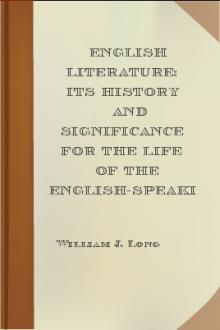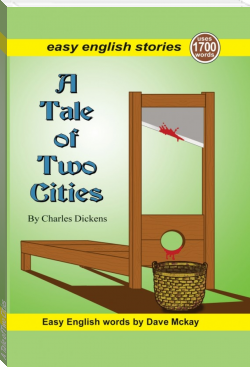English Literature: Its History and Significance for the Life of the English-Speaking World by William J. Long (good books for 8th graders txt) 📕

- Author: William J. Long
- Performer: -
Book online «English Literature: Its History and Significance for the Life of the English-Speaking World by William J. Long (good books for 8th graders txt) 📕». Author William J. Long
The Story ElementMeaning of the Novel. Probably the most significant remark made by the ordinary reader concerning a work of fiction takes the form of a question: Is it a good story? For the reader of to-day is much like the child and the primitive man in this respect, that he must be attracted and held by the story element of a narrative before he learns to appreciate its style or moral significance. The story element is therefore essential to the novel; but where the story originates is impossible to say. As well might we seek for the origin of the race; for wherever primitive men are found, there we see them gathering eagerly about the story-teller. In the halls of our Saxon ancestors the scop and the tale-bringer were ever the most welcome guests; and in the bark wigwams of the American Indians the man who told the legends of Hiawatha had an audience quite as attentive as that which gathered at the Greek festivals to hear the story of Ulysses's wanderings. To man's instinct or innate love for a story we are indebted for all our literature; and the novel must in some degree satisfy this instinct, or fail of appreciation.
The RomanceThe second question which we ask concerning a work of fiction is, How far does the element of imagination enter into it? For upon the element of imagination depends, largely, our classification of works of fiction into novels, romances, and mere adventure stories. The divisions here are as indefinite as the border land between childhood and youth, between instinct and reason; but there are certain principles to guide us. We note, in the development of any normal child, that there comes a time when for his stories he desires knights, giants, elves, fairies, witches, magic, and marvelous adventures which have no basis in experience. He tells extraordinary tales about himself, which may be only the vague remembrances of a dream or the creations of a dawning imagination,--both of which are as real to him as any other part of life. When we say that such a child "romances," we give exactly the right name to it; for this sudden interest in extraordinary beings and events marks the development of the human imagination,--running riot at first, because it is not guided by reason, which is a later development,--and to satisfy this new interest the romance[212] was invented. The romance is, originally, a work of fiction in which the imagination is given full play without being limited by facts or probabilities. It deals with extraordinary events, with heroes whose powers are exaggerated, and often adds the element of superhuman or supernatural characters. It is impossible to draw the line where romance ends; but this element of excessive imagination and of impossible heroes and incidents is its distinguishing mark in every literature.
The NovelWhere the novel begins it is likewise impossible to say; but again we have a suggestion in the experience of every reader. There comes a time, naturally and inevitably, in the life of every youth when the romance no longer enthralls him. He lives in a world of facts; gets acquainted with men and women, some good, some bad, but all human; and he demands that literature shall express life as he knows it by experience. This is the stage of the awakened intellect, and in our stories the intellect as well as the imagination must now be satisfied. At the beginning of this stage we delight in Robinson Crusoe; we read eagerly a multitude of adventure narratives and a few so-called historical novels; but in each case we must be lured by a story, must find heroes and "moving accidents by flood and field" to appeal to our imagination; and though the hero and the adventure may be exaggerated, they must both be natural and within the bounds of probability. Gradually the element of adventure or surprising incident grows less and less important, as we learn that true life is not adventurous, but a plain, heroic matter of work and duty, and the daily choice between good and evil. Life is the most real thing in the world now,--not the life of kings, or heroes, or superhuman creatures, but the individual life with its struggles and temptations and triumphs or failures, like our own; and any work that faithfully represents life becomes interesting. So we drop the adventure story and turn to the novel. For the novel is a work of fiction in which the imagination and the intellect combine to express life in the form of a story and the imagination is always directed and controlled by the intellect. It is interested chiefly, not in romance or adventure, but in men and women as they are; it aims to show the motives and influences which govern human life, and the effects of personal choice upon character and destiny. Such is the true novel,[213] and as such it opens a wider and more interesting field than any other type of literature.
Precursors of the Novel. Before the novel could reach its modern stage, of a more or less sincere attempt to express human life and character, it had to pass through several centuries of almost imperceptible development. Among the early precursors of the novel we must place a collection of tales known as the Greek Romances, dating from the second to the sixth centuries. These are imaginative and delightful stories of ideal love and marvelous adventure,[214] which profoundly affected romance writing for the next thousand years. A second group of predecessors is found in the Italian and Spanish pastoral romances, which were inspired by the Eclogues of Virgil. These were extremely popular in the fourteenth and fifteenth centuries, and their influence is seen later in Sidney's Arcadia, which is the best of this type in English.
The third and most influential group of predecessors of the novel is made up of the romances of chivalry, such as are found in Malory's Morte d'Arthur. It is noticeable, in reading these beautiful old romances in different languages, that each nation changes them somewhat, so as to make them more expressive of national traits and ideals. In a word, the old romance tends inevitably towards realism, especially in England, where the excessive imagination is curbed and the heroes become more human. In Malory, in the unknown author of Sir Gawain and the Green Knight, and especially in Chaucer, we see the effect of the practical English mind in giving these old romances a more natural setting, and in making the heroes suggest, though faintly, the men and women of their own day. The Canterbury Tales, with their story interest and their characters delightfully true to nature, have in them the suggestion, at least, of a connected story whose chief aim is to reflect life as it is.
In the Elizabethan Age the idea of the novel grows more definite. In Sidney's Arcadia (1580), a romance of chivalry, the pastoral setting at least is generally true to nature; our credulity is not taxed, as in the old romances, by the continual appearance of magic or miracles; and the characters, though idealized till they become tiresome, occasionally give the impression of being real men and women. In Bacon's The New Atlantis (1627) we have the story of the discovery by mariners of an unknown country, inhabited by a superior race of men, more civilized than ourselves,--an idea which had been used by More in his Utopia in 1516. These two books are neither romances nor novels, in the strict sense, but studies of social institutions. They use the connected story as a means of teaching moral lessons, and of bringing about needed reforms; and this valuable suggestion has been adopted by many of our modern writers in the so-called problem novels and novels of purpose.
Nearer to the true novel is Lodge's romantic story of Rosalynde, which was used by Shakespeare in As You Like It. This was modeled upon the Italian novella, or short story, which became very popular in England during the Elizabethan Age. In the same age we have introduced into England the Spanish picaresque novel (from picaro, a knave or rascal), which at first was a kind of burlesque on the mediæval romance, and which took for its hero some low scoundrel or outcast, instead of a knight, and followed him through a long career of scandals and villainies. One of the earliest types of this picaresque novel in English is Nash's The Unfortunate Traveller, or the Life of Jack Wilton (1594), which is also a forerunner of the historical novel, since its action takes place during that gorgeous interview between Henry VIII and the king of France on the Field of the Cloth of Gold. In all these short stories and picaresque novels the emphasis was laid not so much on life and character as on the adventures of the hero; and the interest consisted largely in wondering what would happen next, and how the plot would end. The same method is employed in all trashy novels and it is especially the bane of many modern story-writers. This excessive interest in adventures or incidents for their own sake, and not for their effect on character, is what distinguishes the modern adventure story from the true novel.
In the Puritan Age we approach still nearer to the modern novel, especially in the work of Bunyan; and as the Puritan always laid emphasis on character, stories appeared having a definite moral purpose. Bunyan's The Pilgrim's Progress (1678) differs from the Faery Queen, and from all other mediæval allegories, in this important respect,--that the characters, far from being bloodless abstractions, are but thinly disguised men and women. Indeed, many a modern man, reading the story of the Christian;--has found in it the reflection of his own life and experience. In The Life and Death of Mr. Badman (1682) we have another and even more realistic study of a man as he was in Bunyan's day. These two striking figures, Christian and Mr. Badman, belong among the great characters of English fiction. Bunyan's good work,--his keen insight, his delineation of character, and his emphasis upon the moral effects of individual action,--was carried on by Addison and Steele some thirty years later. The character of Sir Roger de Coverley is a real reflection of English country life in the eighteenth century; and with Steele's domestic sketches in The Tatler, The Spectator, and The Guardian (1709-1713), we definitely cross the border land that lies outside of romance, and enter the region of character study where the novel has its beginning.
The Discovery of the Modern Novel. Notwithstanding this long history of fiction, to which we have called attention, it is safe to say that, until the publication of Richardson's Pamela in 1740, no true novel had appeared in any literature. By a true novel we mean simply a work of fiction which relates the story of a plain human life, under stress of emotion, which depends for its interest not on incident or adventure, but on its truth to nature. A number of English novelists--Goldsmith, Richardson, Fielding, Smollett, Sterne--all seem to have seized upon the idea of reflecting life as it is, in the form of a story, and to have developed it simultaneously. The result was an extraordinary awakening of interest, especially among people who had never before been greatly concerned with literature. We are to remember that, in previous periods, the number of readers was comparatively small; and





Comments (0)